
Lifelong Care
Diabetes is a lifelong disease that cannot be cured with
exceptions being extremely rare. Patients are, therefore,
advised to manage their condition.
If diabetes is left untreated or mismanaged for a long time, it
can create numerous complications. For example, diabetes can
cause stiffening of the blood vessels, and a consequent
reduction in oxygen and nutrients to the tissues. This could
happen to the large blood vessels (macro vascular) to the heart,
brain and legs, and to the small vessel networks (micro vascular)
such as those to the eyes, kidneys, and nerves.
The long-term complications of diabetes include strokes,
cardiovascular attacks, poor blood circulation in legs, eye
problems like retinopathy, kidney issues like nephropathy, and
nerve ailments in lower limbs.

Managing the Disease
Without Insulin
Due to the severe complications of diabetes, it is imperative
that patients manage their condition. Most patients of type 2
diabetes try to manage their condition without using insulin, and
their bodies respond well to dietary changes. Overweight people especially feel a dramatic improvement in their health condition
once they manage to lower their weight and maintain it.
Sometimes, however, dietary changes do not prove sufficient to keep
diabetes in check. Such patients resort to medical tablets, which
constitute a temporary measure and will stop working eventually.
Once that happens, the only recourse is to take insulin. A small
portion of patients whose condition is too severe upon diagnosis are
recommended to take insulin right away.

For patients who adopt the non-insulin method, it is important that
they learn what type of food they should include in their diet and
how much of a specific food item they should eat. Patients should
also keep track of what they eat and how that impacts their medical
condition.
One good course of action in this regard is to consult a dietitian,
a diabetes specialist, or a doctor and strictly follow their
guidance and advice. Patients can also help themselves to recipe
books written specifically for diabetics and come up with a meal
plan that suits both their conditional requirements and taste buds.
A local diabetes organization may offer tremendous help in this
regard and make appropriate recommendations.
Apart from dietary considerations, exercising and physical activity
can do wonders for diabetics as well as those who are in the
prediabetes phase. Exercise is shown to significantly decrease the
chances of being afflicted with diabetes.

Patients should think and determine what type of exercise suits their lifestyle. It can simply
be regular brisk walking, mild jogging, or a full body workout with
comfortable weights. A fitness expert or trainer at the local
gymnasium can offer useful tips in this regard. The expert can
perhaps formulate an exercise plan for the patient. The patient can
discuss the plan later with his/her diabetes counselor, who can make
appropriate changes.
If the patient does not want to join a fitness center, there are
many physical activities that he/she can engage in on their own.
Here are a few tips: Walk as much as you can and if you are going to
a place nearby, ditch the car keys. Take the stairs instead of the
lift. If you have a pet dog, take it out for long walks several
times a week. Engage regularly in swimming sessions. Consider
investing in a bicycle for commute or perhaps buy a stationary bike
for home workouts.

With Insulin
While managing diabetes without insulin is very much a
possibility, some patients unfortunately do not have that choice.
People who suffer from acute insulin deficiencies, especially type 1
patients, may not survive without insulin injections. Furthermore,
people who have had type 2 diabetes for a long time are eventually
advised to take insulin due to the progressive nature of this
disease.
Insulin cannot be taken by mouth because it gets inactivated long
before it reaches the bloodstream where it is actually needed.
Insulin, therefore, needs to be administered through an injection.
There is, however, a type of insulin that is inhalable, but it may
not be readily available.
Around one-fourth of diabetics are known to seek the insulin
treatment. All the children diagnosed with diabetes are directly
placed on the insulin treatment method. Adult patients of diabetes,
who have satisfactorily manage their condition for years, eventually
need to take insulin injections to make up for the dwindling amount
of insulin released from their pancreas.

Most diabetics do not feel comfortable with the idea of self-injection. However, technology has brought us a long way from the use of traditional syringes. There are now sophisticated pens and needles that are used specifically for administering insulin. These modern devices are so ingenious that the patient’s fear of needles disappears after only a few uses and, before long, they become part of the patient’s routine.